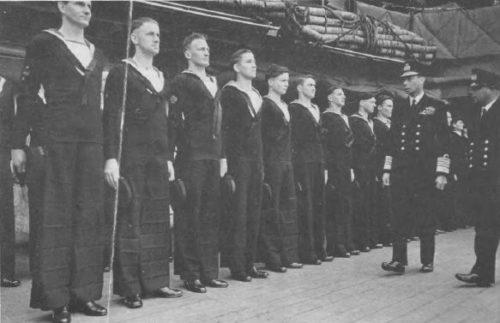- Author
- Yeomans, Jim
- Subjects
- Biographies and personal histories, History - WW2
- Tags
-
- RAN Ships
- HMAS Shropshire
- Publication
- March 1991 edition of the Naval Historical Review (all rights reserved)
Siegfried was very proud of the manner in which his side handled ‘Operation Cerberus’ and rightly so. Details of the break-out do not reflect a lot of credit on our side. The break-out commenced at Brest on 11 February, 1942 at 9.30 pm – two hours behind schedule because of a raid by 16 Wellington bombers on the port. A break-out up the Channel was considered suicidal and never taken as a possibility. First sighting of the three big ships was made by a Spitfire at 10.42 am the next day and at first not taken seriously. The first attack was a suicidal one by six torpedo carrying Swordfish, 90 mph ‘Flying String Bags’ escorted by only 10 Spitfires instead of the 5 squadrons ordered. None of the pilots had been told the nature of their target. All Swordfish were destroyed and only five of the 18 crew members survived.
At 2.31 pm (12th), Scharnhorst hit a mine and Admiral Cileax transferred to destroyer Z.29, unnecessarily as it turned out, because the big ship was underway again at 3 pm and soon worked up to 27 knots. The old destroyers HMS Campbell, Mackay, Vivacious, Whitshed and Worcester made a torpedo attack at 3.45 pm, lasting 11 minutes, with no result but Worcester was badly disabled and barely managed to limp back to port with 130 casualties. These destroyers were given a very trying time by RAF bombers!
At 7.55 pm (12th), near Friesian Islands, Gneisenau hit a mine and was holed on the starboard side, but the damage was slight and it was underway again only half an hour later.
Just 10 miles from the Dutch coast at 9.35 pm, Scharnhorst hit a second mine which damaged the starboard main engine, and although it lost all communications, was moving again just 35 minutes later. At 1 am (13th) the British admitted that the big German ships were safe. HMS Shropshire had been in the area but taken no part.
Ultimately, Gneisenau was smashed in dry dock at Kiel by RAF bombers on 25th & 27th February and was eventually towed to Gydnia (Poland), filled with concrete and used as a block-ship fort. On 23rd February, Prinz Eugen was torpedoed by submarine HMS Trident, never went to sea again and was eventually destroyed in 1948 in atomic tests at Bikini Atoll.
After long periods of inactivity, brought about by Hitler’s reluctance to expose his big ships to British warships, on 26th December, 1943, Scharnhorst was eventually cornered by the cruisers Norfolk and Belfast who held her on radar off North Cape until the arrival of the modern battle-ship Duke of York which smashed it with 14″ guns. It was eventually sunk by torpedoes from Jamaica. Only 36 survivors from the crew of 1,940 men were plucked from the icy seas.
It appears that Siegfried’s life would have been prolonged for only a short period had he remained with his beloved ship!





